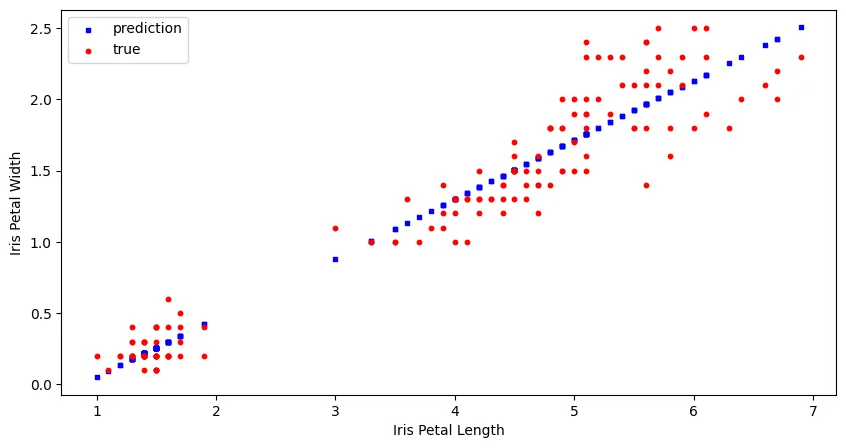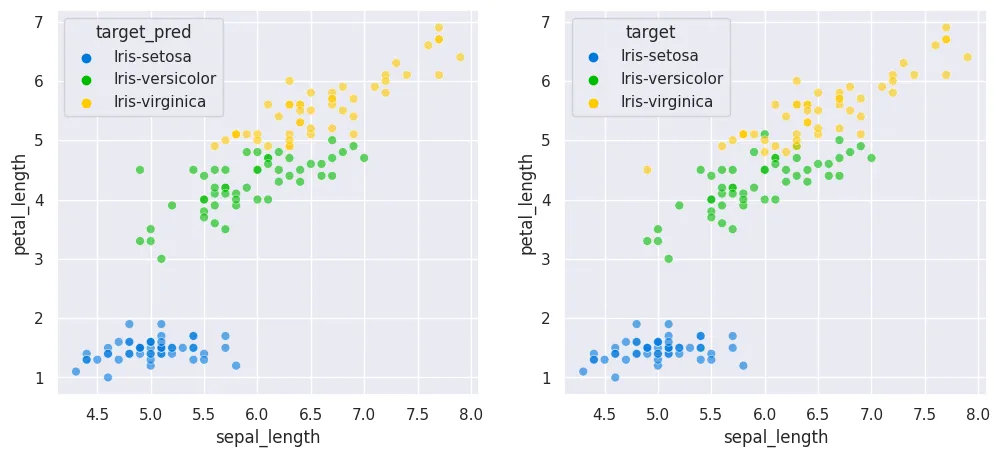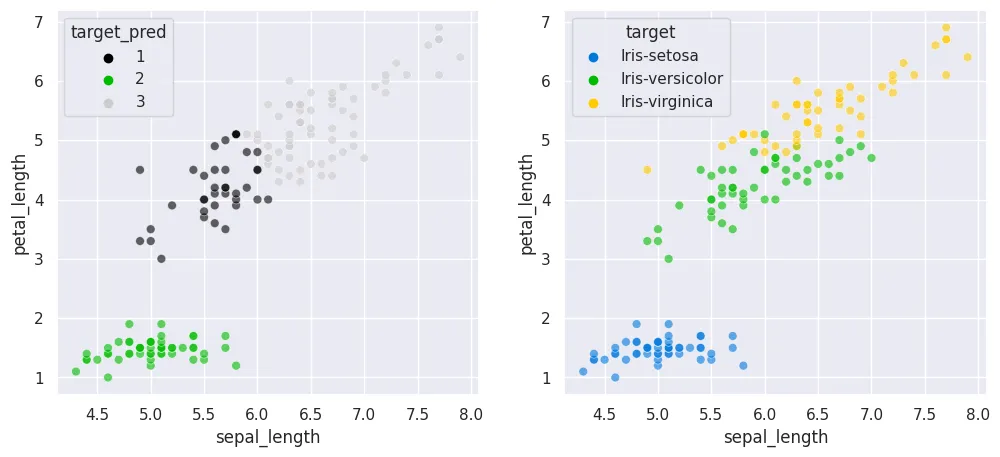
SQL in Data Science
PostgreSQL lets you build queries which run a variety of machine learning algorithms against your data.
- SQL in Data Science - The Basics using Python
- SQL in Data Science - Slightly more Advanced Queries
- SQL in Data Science - Machine Learning
Database Installation with Docker Compose
mkdir /opt/pgdata
sudo chown myuser:myuser /opt/pgdata
sudo chmod 777 /opt/pgdata
docker pull postgres:alpine
docker-compose.yml
# Use postgres/example user/password credentials
version: '3'
services:
db:
image: postgres:alpine
restart: unless-stopped
environment:
POSTGRES_USER: postgres
POSTGRES_PASSWORD: password
POSTGRES_DB: testing
PGDATA: /var/lib/postgresql/data/pgdata
volumes:
- /opt/pgdata:/var/lib/postgresql/data
ports:
- 5432:5432
adminer:
image: adminer
restart: unless-stopped
ports:
- 8080:8080
docker-compose up
import psycopg2
from config import config
import pandas as pd
import matplotlib.pyplot as plt
import seaborn as sns
Dataset
!wget https://gist.github.com/Thanatoz-1/9e7fdfb8189f0cdf5d73a494e4a6392a/raw/aaecbd14aeaa468cd749528f291aa8a30c2ea09e/iris_dataset.csv
data_iris = pd.read_csv ('iris_dataset.csv')
df_iris = pd.DataFrame(data_iris)
df_iris.rename(columns={
'sepal length (cm)': 'sepal_length',
'sepal width (cm)': 'sepal_width',
'petal length (cm)': 'petal_length',
'petal width (cm)': 'petal_width',
}, inplace=True)
df_iris.head(5)
| sepal_length | sepal_width | petal_length | petal_width | target | |
|---|---|---|---|---|---|
| 0 | 5.1 | 3.5 | 1.4 | 0.2 | Iris-setosa |
| 1 | 4.9 | 3.0 | 1.4 | 0.2 | Iris-setosa |
| 2 | 4.7 | 3.2 | 1.3 | 0.2 | Iris-setosa |
| 3 | 4.6 | 3.1 | 1.5 | 0.2 | Iris-setosa |
| 4 | 5.0 | 3.6 | 1.4 | 0.2 | Iris-setosa |
def create_table():
conn = None
try:
# read database configuration
params = config()
# connect to the PostgreSQL database
conn = psycopg2.connect(**params)
# create a new cursor
cursor = conn.cursor()
# create the table
cursor.execute('''
CREATE TABLE iris (
index SMALLINT primary key,
sepal_length FLOAT,
sepal_width FLOAT,
petal_length FLOAT,
petal_width FLOAT,
target VARCHAR
)
''')
conn.commit()
# Close communication with the PostgreSQL database
cursor.close()
except (Exception, psycopg2.DatabaseError) as error:
print(error)
def add_data():
conn = None
try:
# read database configuration
params = config()
# connect to the PostgreSQL database
conn = psycopg2.connect(**params)
# create a new cursor
cursor = conn.cursor()
# insert data
for row in df_iris.itertuples():
cursor.execute('''
INSERT INTO iris (
index, sepal_length, sepal_width, petal_length, petal_width, target
) VALUES (
%s, %s, %s, %s, %s, %s
)''',
(
row.Index,
row.sepal_length,
row.sepal_width,
row.petal_length,
row.petal_width,
row.target
)
)
# Commit the changes to the database
conn.commit()
# Close communication with the PostgreSQL database
cursor.close()
except (Exception, psycopg2.DatabaseError) as error:
print(error)
create_table()
add_data()
Linear Regression
query = f"""
WITH regression AS
(SELECT
regr_slope(petal_width, petal_length) AS gradient,
regr_intercept(petal_width, petal_length) AS intercept
FROM
iris
WHERE
petal_width IS NOT NULL
)
SELECT
petal_length,
(petal_length * gradient) + intercept AS prediction
FROM
iris
CROSS JOIN
regression
WHERE
petal_width IS NOT NULL ;
"""
def linear_regression(query):
conn = None
try:
params = config()
conn = psycopg2.connect(**params)
cursor = conn.cursor()
query = query
cursor.execute(query)
results = cursor.fetchall()
cursor.close()
except (Exception, psycopg2.DatabaseError) as error:
print(error)
finally:
if conn is not None:
return(results)
conn.close()
results = linear_regression(query=query)
df_pred = pd.DataFrame(results, columns=['petal_length', 'petal_width_pred'])
df_pred.head()
| petal_length | petal_width_pred | |
|---|---|---|
| 0 | 1.4 | 0.216473 |
| 1 | 1.4 | 0.216473 |
| 2 | 1.3 | 0.174831 |
| 3 | 1.5 | 0.258115 |
| 4 | 1.4 | 0.216473 |
fig = plt.figure(figsize=(10,5))
ax1 = fig.add_subplot(111)
ax1.scatter(data=df_pred, x='petal_length', y='petal_width_pred', s=10, c='b', marker="s", label='prediction')
ax1.scatter(data=df_iris, x='petal_length', y='petal_width', s=10, c='r', marker="o", label='true')
plt.legend(loc='upper left')
plt.xlabel('Iris Petal Length')
plt.ylabel('Iris Petal Width')
plt.savefig('assets/sql-for-data-science_01.webp', bbox_inches='tight')

K-Nearest Neighbours
query = f'''
-- CTE to get labelled training data
WITH training AS
(SELECT
index,
POINT(sepal_length, petal_length) as xy,
target
FROM
iris
WHERE
target IS NOT NULL
),
-- CTE to get the unlabelled points
test AS
(SELECT
index,
POINT(sepal_length, petal_length) as xy,
target
FROM
iris
WHERE
target IS NOT NULL
),
-- calculate distances between unlabelled & labelled points
distances AS
(SELECT
test.index,
training.target,
test.xy <-> training.xy AS dist,
ROW_NUMBER() OVER (
PARTITION BY test.index
ORDER BY test.xy <-> training.xy
) AS row_no
FROM
test
CROSS JOIN training
ORDER BY 1, 4 ASC
),
-- count the 'votes' per label for each unlabelled point
votes AS
(SELECT
index,
target,
count(*) AS votes
FROM distances
WHERE row_no <= 5
GROUP BY 1,2
ORDER BY 1)
-- query for the label with the most votes
SELECT
v.index,
v.target
FROM
votes v
JOIN
(SELECT
index,
max(votes) AS max_votes
FROM
votes
GROUP BY 1
) mv
ON v.index = mv.index
AND v.votes = mv.max_votes
ORDER BY 1 ASC ;
'''
def k_nearest_neighbours(query):
conn = None
try:
params = config()
conn = psycopg2.connect(**params)
cursor = conn.cursor()
query = query
cursor.execute(query)
results = cursor.fetchall()
cursor.close()
except (Exception, psycopg2.DatabaseError) as error:
print(error)
finally:
if conn is not None:
return(results)
conn.close()
# run training with k=5
results = k_nearest_neighbours(query=query)
df_pred = pd.DataFrame(results, columns=['index', 'target_pred'])
df_pred.head()
| index | target_pred | |
|---|---|---|
| 0 | 0 | Iris-setosa |
| 1 | 1 | Iris-setosa |
| 2 | 2 | Iris-setosa |
| 3 | 3 | Iris-setosa |
| 4 | 4 | Iris-setosa |
df_iris['target_pred'] = df_pred['target_pred']
df_iris.head()
| sepal_length | sepal_width | petal_length | petal_width | target | target_pred | |
|---|---|---|---|---|---|---|
| 0 | 5.1 | 3.5 | 1.4 | 0.2 | Iris-setosa | Iris-setosa |
| 1 | 4.9 | 3.0 | 1.4 | 0.2 | Iris-setosa | Iris-setosa |
| 2 | 4.7 | 3.2 | 1.3 | 0.2 | Iris-setosa | Iris-setosa |
| 3 | 4.6 | 3.1 | 1.5 | 0.2 | Iris-setosa | Iris-setosa |
| 4 | 5.0 | 3.6 | 1.4 | 0.2 | Iris-setosa | Iris-setosa |
fig, axes = plt.subplots(1, 2, figsize=(12,5))
sns.scatterplot(
x='sepal_length',
y='petal_length',
data=df_iris,
s=40,
alpha=0.6,
hue='target_pred',
palette='nipy_spectral',
ax=axes[0]
)
sns.scatterplot(
x='sepal_length',
y='petal_length',
data=df_iris,
s=40,
alpha=0.6,
hue='target',
palette='nipy_spectral',
ax=axes[1]
)
plt.savefig('assets/sql-for-data-science_02.webp', bbox_inches='tight')

K-means Clustering
query = f'''
WITH points AS
(SELECT
index,
POINT(sepal_length, petal_length) AS xy
FROM
iris
),
initial AS
(SELECT
RANK() OVER (
ORDER BY random()
) AS cluster,
xy
FROM points
-- set k=3 since we know there are 3 classes
LIMIT 3
),
iteration AS
(WITH RECURSIVE kmeans(iter, index, cluster, avg_point) AS (
SELECT
1,
NULL::INTEGER,
*
FROM
initial
UNION ALL
SELECT
iter + 1,
index,
cluster,
midpoint
FROM (
SELECT DISTINCT ON(iter, index)
*
FROM (
SELECT
iter,
cluster,
p.index,
p.xy <-> k.avg_point AS distance,
@@ LSEG(p.xy, k.avg_point) AS midpoint,
p.xy,
k.avg_point
FROM points p
CROSS JOIN kmeans k
) d
ORDER BY 1, 3, 4
) r
WHERE iter < 1000
)
SELECT
*
FROM
kmeans
)
SELECT
k.*,
cluster
FROM
iteration i
JOIN
iris k
USING(index)
WHERE
iter = 1000
ORDER BY 4,1 ASC ;
'''
def k_means(query):
conn = None
try:
params = config()
conn = psycopg2.connect(**params)
cursor = conn.cursor()
query = query
cursor.execute(query)
results = cursor.fetchall()
cursor.close()
except (Exception, psycopg2.DatabaseError) as error:
print(error)
finally:
if conn is not None:
return(results)
conn.close()
# run training with k=3 / max_iter=1000
results = k_nearest_neighbours(query=query)
df_pred = pd.DataFrame(results, columns=['index', 'sepal_length', 'sepal_width', 'petal_length', 'petal_width', 'target', 'target_pred'])
df_pred.head()
fig, axes = plt.subplots(1, 2, figsize=(12,5))
sns.scatterplot(
x='sepal_length',
y='petal_length',
data=df_pred,
s=40,
alpha=0.6,
hue='target_pred',
palette='nipy_spectral',
ax=axes[0]
)
sns.scatterplot(
x='sepal_length',
y='petal_length',
data=df_pred,
s=40,
alpha=0.6,
hue='target',
palette='nipy_spectral',
ax=axes[1]
)
plt.savefig('assets/sql-for-data-science_03.webp', bbox_inches='tight')

Dataset II
!wget https://github.com/mohitgupta-omg/Kaggle-SMS-Spam-Collection-Dataset-/raw/master/spam.csv
data_spam = pd.read_csv ('spam_dataset.csv')
df_spam = pd.DataFrame(data_spam)
df_spam = df_spam.reset_index()
df_spam.head(5)
| index | cat | sms |
|---|---|---|
| 0 | ham | Go until jurong point crazy.. Available only i... |
| 1 | ham | Ok lar... Joking wif u oni... |
| 2 | spam | Free entry in 2 a wkly comp to win FA Cup fina... |
| 3 | ham | U dun say so early hor... U c already then say... |
| 4 | ham | Nah I don't think he goes to usf he lives arou... |
def create_table():
conn = None
try:
# read database configuration
params = config()
# connect to the PostgreSQL database
conn = psycopg2.connect(**params)
# create a new cursor
cursor = conn.cursor()
# create the table
cursor.execute('''
CREATE TABLE spam (
index SMALLINT primary key,
cat VARCHAR,
sms VARCHAR
)
''')
conn.commit()
# Close communication with the PostgreSQL database
cursor.close()
except (Exception, psycopg2.DatabaseError) as error:
print(error)
def add_data():
conn = None
try:
# read database configuration
params = config()
# connect to the PostgreSQL database
conn = psycopg2.connect(**params)
# create a new cursor
cursor = conn.cursor()
# insert data
for row in df_spam.itertuples():
cursor.execute('''
INSERT INTO spam (
index, cat, sms
) VALUES (
%s, %s, %s
)''',
(
row.index,
row.cat,
row.sms
)
)
# Commit the changes to the database
conn.commit()
# Close communication with the PostgreSQL database
cursor.close()
except (Exception, psycopg2.DatabaseError) as error:
print(error)
create_table()
add_data()
Naive Bayes Classification
query = f'''
-- CTE to create one row per word
WITH staging AS
(SELECT
REGEXP_SPLIT_TO_TABLE(
LOWER(sms), '[^a-z]+') AS word,
cat
FROM
spam
WHERE
cat IS NOT NULL
),
-- testing data
test AS
(SELECT
index,
sms
FROM
spam
WHERE
cat is NOT NULL
),
-- one row per word + cat
cartesian AS
(SELECT
*
FROM
(SELECT
DISTINCT word
FROM
staging) w
CROSS JOIN
(SELECT
DISTINCT cat
FROM
staging) c
WHERE
length(word) > 0
),
-- CTE of smoothed frequencies of each word by cat
frequencies AS
(SELECT
c.word,
c.cat,
-- numerator plus one
(SELECT
count(*)+1
FROM
staging s
WHERE
s.word = c.word
AND
s.cat = c.cat) /
-- denominator plus two
(SELECT
count(*)+2
FROM
staging s1
WHERE
s1.cat = c.cat) ::DECIMAL AS freq
FROM
cartesian c
),
-- for each row in testing, get the probabilities
probabilities AS
(SELECT
t.index,
f.cat,
SUM(LN(f.freq)) AS probability
FROM
(SELECT
index,
REGEXP_SPLIT_TO_TABLE(
LOWER(sms), '[^a-z]+') AS word
FROM
test) t
JOIN
(SELECT
word,
cat,
freq
FROM
frequencies) f
ON t.word = f.word
GROUP BY 1, 2
)
-- keep only the highest estimate
SELECT
sms,
probabilities.cat
FROM
probabilities
JOIN
(SELECT
index,
max(probability) AS max_probability
FROM
probabilities
GROUP BY 1) p
ON probabilities.index = p.index
AND probabilities.probability = p.max_probability
JOIN
test
ON probabilities.index = test.index
ORDER BY 1 ;
'''
def naive_bayes(query):
conn = None
try:
params = config()
conn = psycopg2.connect(**params)
cursor = conn.cursor()
query = query
cursor.execute(query)
results = cursor.fetchall()
cursor.close()
except (Exception, psycopg2.DatabaseError) as error:
print(error)
finally:
if conn is not None:
return(results)
conn.close()
# buckle up....this will take a while
results = naive_bayes(query=query)
df_pred = pd.DataFrame(results, columns=['message', 'cat_pred'])
df_pred[df_pred['cat_pred'] == 'ham'].head(25)
| message | cat_pred | |
|---|---|---|
| 0 | all write or wat.. | ham |
| 1 | bot notes oredi... Cos i juz rem i got... | ham |
| 2 | called dad oredi... | ham |
| 3 | collecting ur laptop then going to configu... | ham |
| 4 | come lt 25 n pass to me lar | ham |
| 5 | comin to fetch us oredi... | ham |
| 6 | dun need to pick ur gf? | ham |
| 7 | dun wan to watch infernal affair? | ham |
| 8 | eatin later but i'm eatin wif my frens now... | ham |
| 9 | give me some time to walk there. | ham |
| 10 | go home liao? Ask dad to pick me up at 6... | ham |
| 11 | got wat to buy tell us then _ no need to... | ham |
| 12 | log off 4 wat. It's sdryb8i | ham |
| 13 | mean it's confirmed... I tot they juz say ... | ham |
| 14 | neva tell me how i noe... I'm not at home ... | ham |
| 15 | no home work to do meh... | ham |
| 16 | only send me the contents page... | ham |
| 17 | predict wat time _'ll finish buying? | ham |
| 18 | ready then call me... | ham |
| 19 | say until like dat i dun buy ericsson oso ... | ham |
| 20 | still attending da talks? | ham |
| 21 | still got lessons? in sch? | ham |
| 23 | thk of wat to eat tonight. | ham |
| 24 | v ma fan... | ham |
| 25 | wait 4 me in sch i finish ard 5.. | ham |
df_pred[df_pred['cat_pred'] == 'spam'].head(25)
| message | cat_pred | |
|---|---|---|
| 22 | takin linear algebra today? | spam |
| 34 | and picking them up from various points | spam |
| 53 | (Bank of Granite issues Strong-Buy) EXPLOSIVE ... | spam |
| 60 | * FREE* POLYPHONIC RINGTONE Text SUPER to 8713... | spam |
| 68 | FREE MESSAGEThanks for using the Auction S... | spam |
| 70 | +123 Congratulations - in this week's competit... | spam |
| 71 | +123 Congratulations - in this week's competit... | spam |
| 72 | +449071512431 URGENT! This is the 2nd attempt ... | spam |
| 73 | -PLS STOP bootydelious (32/F) is inviting you ... | spam |
| 77 | 07732584351 - Rodger Burns - MSG = We tried to... | spam |
| 78 | 08714712388 between 10am-7pm Cost 10p | spam |
| 79 | 09066362231 URGENT! Your mobile No 07xxxxxxxxx... | spam |
| 80 | 0A$NETWORKS allow companies to bill for SMS so... | spam |
| 91 | 100 dating service cal;l 09064012103 box334sk38ch | spam |
| 92 | 1000's flirting NOW! Txt GIRL or BLOKE & ur NA... | spam |
| 93 | 1000's of girls many local 2 u who r virgins 2... | spam |
| 94 | 18 days to Euro2004 kickoff! U will be kept in... | spam |
| 95 | 18 days to Euro2004 kickoff! U will be kept in... | spam |
| 96 | 1Apple/Day=No Doctor. 1Tulsi Leaf/Day=No Cance... | spam |
| 97 | 1st wk FREE! Gr8 tones str8 2 u each wk. Txt N... | spam |
| 101 | 2/2 146tf150p | spam |
| 102 | 22 days to kick off! For Euro2004 U will be ke... | spam |
| 103 | 25p 4 alfie Moon's Children in need song on ur... | spam |
| 104 | 26th OF JULY | spam |
| 107 | 2p per min to call Germany 08448350055 from yo... | spam |